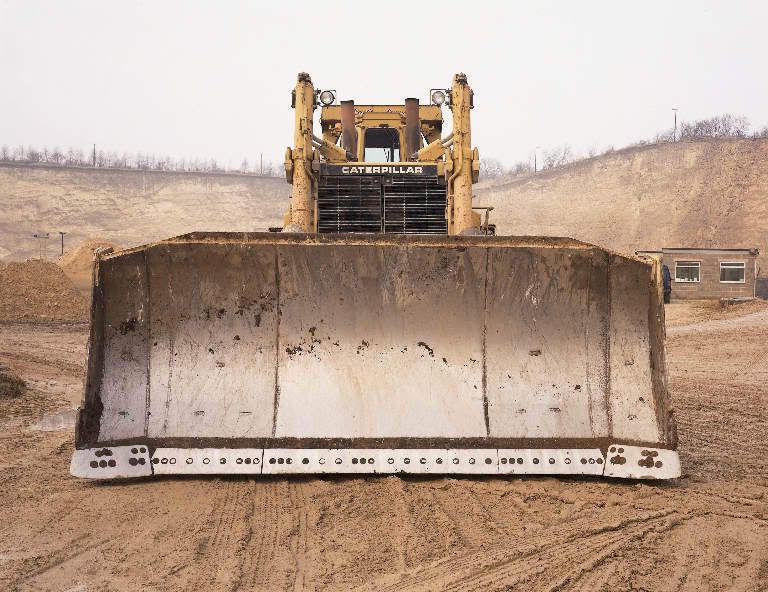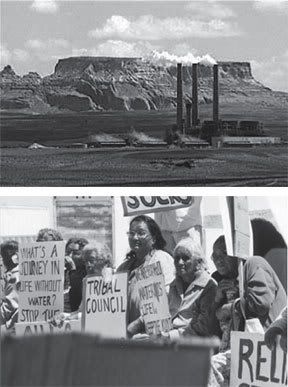by Winter Rabbit | 10/11/2008 08:07:00 AM
For more clarification,see here.
U.S. Sen. John McCain sponsored S1003, which was concluded to be “another step in the relocation process” of the Navajo. S 1103 passed the Senate, but it never made it to the House. However, P.L. 104-301, which McCain was actively involved with, passed both houses in 1996 and included a clause for condemnation and monies to the State of Arizona. Section 6 of P.L. 104-301 states, “Secretary shall take those lands into trust for the Tribe in accordance with this Act and the Settlement Agreement.” When the recent television show '30 Days' showed “Americas dirty little secret,” it became obvious that trust duties from P.L. 104-301 have not been being honored.
A person is innocent until proven guilty in the case of Egesdale, whose name I hopefully spelled right, in the following video at about 30 minutes. I looked for a power transfer wherein McCain could have double spoken.
I think at least that it points in the right direction, and the UN stated this was “the first time the U.S. is being formally investigated by the United Nations for violations of the right to freedom of religion or belief.”
John McCain in on the record as saying, “the reason why the office of Navajo and Hopi Indian Relocation was created originally, was because of the belief that the BIA couldn't handle it.” Interesting, because the beginning of this video shows the BIA impounding cattle.
What year was that? The "BIA couldn't handle" what McCain?
What’s more interesting, is this.
Oh look, "TheCommissioner, no the Navajo and Hopi Indian Relocation office, no, the U.S. government with McCain at the helm in the relevant timeline, the U.S. Mining company security personnel, Peabody Coal's bulldozers, armed rangers, and the BIA shall have all the powers and be responsible for all the duties that the Navajo and Hopi Indian Relocation Commission ??????? had before November 16, 1988."
Confused yet? That’s what this “legislation” was supposed to do. It was supposed to hide McCain’s involvement to steal land, and the violations of human rights remains hidden as well to the overall public. “In 1996, Congress passed a law endorsing a 75-year lease arrangement that would allow a few of the families to remain as tenants on the land. The law sanctions the relocation of families not eligible for these leases and forces the families who sign the leases to live without benefit of civil and religious rights exercised by other Americans” the UN told us. Also, PL 104-301 tells us that "the number of homesites available for lease is 112," yet adds, "additional homesites may be made
available subject to agreement between the Hopi Tribe and homesite applicant." Quite generous in light of the forced relocation of 10,000 Navajos. One forced relocation is a tragedy, but apparently 10,000 or more is just a statistic. The UN also told us about the loss of voting rights, the physical harassment of elders, intimidation tactics, that armed rangers visited elders at their homes and stole their property, and that their sacred sites were bulldozed - including their graveyards.
This, has been America’s West Bank:


…human rights violations and an institutionalized racism against indigenous peoples is alive and thriving in the United States...
The Shadow Report Outlines the following: critical things the U.S. Periodic Report omitted that were supposed to have been reported to the Human Rights Committee; Un – recognized Indigenous Peoples of which “many have waited decades” for recognition; the “Indian Reservation Apartheid;” the “Life Expectancy on the Indian Reservation” with its “high rate of infant mortality, cancer, diabetes, and heart disease;” poverty and unemployment, overall problems with justice; “Racially Discriminatory Constitutional Foundations;” religious freedom as it relates to access to sacred lands; “Environmental Racism and its effects on Indigenous Human Rights,” that “you cannot damage the land without damaging those who live upon it;” “The Denial of Human Rights and Fundamental Freedoms in the Political, Economic, Social, Cultural, or any Other Field of Public Life;” “Racist Science and the Collective Right of Free, Prior and Informed Consent;” “Articles 6 and 7,” which mention the devastation of Indian Boarding Schools and “Racist Sports Mascots and Logos;” and finally, “The United States and its Transnational Companies and Violations of the Human Rights of Indigenous Peoples Abroad.”
Source
Not that long ago, the United Nations performed a Human Rights Investigation of the forced Navajo resettlement from Arizona to Nevada, under Special Rapporteur A. Amor. A law revised and submitted to Congress by Senator John McCain and others before him was determined to be the root cause of violations, which after ratification by President Clinton in 1999 during a globally publicized sit in by Songstress Julia Butterfly Hill at Big Mountain, Arizona.
The enactment led to the removal of the Dineh band of Navajo from the Black Mesa to free the lands up to mining, and could lead to relocation of the Dineh-Navaho from Big Mountain, all based on a tissue of deceit, false claims of prior ownership by a small group of paid Arizona locals of Indian descent led by one Wayne Taylor, working for McCain and Peabody.
U.S. Sen. John McCain sponsored S1003, which was concluded to be “another step in the relocation process” of the Navajo. S 1103 passed the Senate, but it never made it to the House. However, P.L. 104-301, which McCain was actively involved with, passed both houses in 1996 and included a clause for condemnation and monies to the State of Arizona. Section 6 of P.L. 104-301 states, “Secretary shall take those lands into trust for the Tribe in accordance with this Act and the Settlement Agreement.” When the recent television show '30 Days' showed “Americas dirty little secret,” it became obvious that trust duties from P.L. 104-301 have not been being honored.
A person is innocent until proven guilty in the case of Egesdale, whose name I hopefully spelled right, in the following video at about 30 minutes. I looked for a power transfer wherein McCain could have double spoken.
Mr. Egesdale, finally, the reason why the office of Navajo and Hopi Indian Relocation was created originally, was because of the belief that the BIA couldn’t handle it. Now, I guess we’re going to turn over a few loose ends to you. Umm, hopefully a minimum. But I hope you give this issue the attention it deserves…including being actively involved in how we can get the Bennett Freeze lifted…
I think at least that it points in the right direction, and the UN stated this was “the first time the U.S. is being formally investigated by the United Nations for violations of the right to freedom of religion or belief.”
Source
The Hopi Tribe is supportive of Senate Bill 1003, the Navajo-Hopi Land Settlement Amendments of 2005 sponsored by U.S. Sen. John McCain of Arizona, according to the chairman.
Source
The Hopi Tribe supports S.1003, sponsored by Sen. John McCain (R-Arizona). It would require Navajo families who remain on Hopi land to relocate to Navajo land, or agree to Hopi jurisdiction if they decide not to move.
Source
CONCLUSION
This Bill is another step in the relocation process. The authors may see it as the final one.
Source
While S1003 passed through the Senate, it never made it out of the House Resources Committee to the House floor for a vote. The congressional session ended with no action being taken.
Source
"Although Senator McCain addressed some of the issues raised by the Navajo Nation, he did not address our principal concerns regarding mitigation of the terrible effects of the relocation program and rehabilitation of the Bennett Freeze area".
S 1003, sponsored by Senator John McCain (R-AZ), comes as Peabody Coal, the world's largest coal company, is planning to expand its strip mining of American Indian lands, drawing down another high-quality residential aquifer in the process. Only one thing stands in Peabody's way: indigenous people live on the land below which lies billions of tons of low-sulfur coal. As with their ancestors, the land is the basis for the Black Mesa people's traditions, spirituality, and livelihoods.
Source
McCain was actively involved with legislation being passed in 1996 regarding Navajo-Hopi Land Settlements. See the 1996 Accommodation Agreement (P.L. 104-301).
Source
III. ACCOMMODATION OF NAVAJOS ON HOPI-PARTITIONED LAND
A. ELIGIBILITY. To any Navajo on List A provided to the
Hopi Tribe, a copy of which is attached hereto as Appendix A,
and, in addition, (i) those Navajos domiciled on the HPL who
are temporarily away for purposes of education, employment,
military service or medical need; (ii) those Navajo legal
residents on the HPL who are subsequently certified eligible
by the Office of Navajo and Hopi Relocation; and (iii) such
other individuals, as agreed to by the Navajo and Hopi tribes,
the Hopi Tribe, will offer a lease allowing that person and
his or her spouse and children to remain on that portion of
the HPL covered by their lease. The number of homesites
available for lease is 112. Additional homesites may be made
available subject to agreement between the Hopi Tribe and
homesite applicant.
Source
McCain was actively involved with legislation being passed in 1996 regarding Navajo-Hopi Land Settlements. See the 1996 Accommodation Agreement (P.L. 104-301).
Source
SEC. 6. ACQUISITION THROUGH CONDEMNATION OF CERTAIN INTERSPERSED LANDS.
(b) DISPOSITION OF LANDS- If the Secretary acquires lands through condemnation under subsection (a), the Secretary shall take those lands into trust for the Tribe in accordance with this Act and the Settlement Agreement.
- snip –
SEC. 8. PAYMENT TO STATE OF ARIZONA.
(b) PAYMENT- The Secretary shall make a payment in the amount specified in subsection (a) to the State of Arizona after an initial acquisition of land from the State has been made by the Secretary pursuant to section 6.
con•demn
4: to declare convertible to public use under the right of eminent domain.
http://www.britannica.com/EBchecked/topic/185870/eminent-domain#tab=active~checked%2Citems~checked&title=eminent%20domain%20--%20Britannica%20Online%20Encyclopedia
condemnation
Power of government to take private property for public use without the owner’s consent.
(B) ACQUISITION THROUGH CONDEMNATION- With respect to a request for an acquisition of lands through condemnation made under subparagraph (A), the Secretary shall, upon the recommendation of the Tribe, take such action as may be necessary to acquire the lands through condemnation and, with funds provided by the Tribe, pay the State of Arizona fair market value for those lands in accordance with applicable Federal law, if the conditions described in paragraph (2) are met.
(2) CONDITIONS FOR ACQUISITION THROUGH CONDEMNATION- The Secretary may acquire lands through condemnation under this subsection if--
(A) that acquisition is consistent with the purpose of obtaining not more than 500,000 acres of land to be taken into trust for the Tribe;
(B) the State of Arizona concurs with the United States that the acquisition is consistent with the interests of the State; and
(C) the Tribe pays for the land acquired through condemnation under this subsection.
Source
The current laws deny the Dineh families who remain on their land a fundamental constitutional right enjoyed by other citizens of the U.S. They are not allowed to vote or in any way to participate in the government which controls their lives. They are not allowed to participate in the legal system other than as defendants. They have no right to appeal any police or government action. Mining company security personnel, harass and intimidate elders, threatening them with imprisonment if they try to protect their homes, property and burial sites from Peabody Coal's bulldozers. They can be arbitrarily thrown in jail for resisting actions by the mining company. People and their livestock are given trespass notices. Ceremonial hogans, houses, sacred sites and graveyards are bulldozed. Armed rangers visit elders at their homes and threaten and harass them and confiscate their livestock at the government's discretion. They are denied access to water, their water wells are fenced, capped off and dismantled.
- snip -
In 1996, Congress passed a law endorsing a 75-year lease arrangement that would allow a few of the families to remain as tenants on the land. The law sanctions the relocation of families not eligible for these leases and forces the families who sign the leases to live without benefit of civil and religious rights exercised by other Americans. In April 1997, when all efforts to obtain justice in the U.S. judicial system failed, and in order to get the relocation laws repealed, the Dineh filed a formal request for the United Nations Commission on Human Rights to conduct an investigation of human rights violations against them by the U.S. government. Several visits to New York by Dineh helped create an Inter-faith coalition of faith-based Non-Governmental Organizations (NGOs). A delegation of NGOs traveled to Black Mesa to witness the historic meeting between the traditional Dineh and Hopi people and Mr. Abdelfattah Amor, Special Rapporteur on Religious Intolerance of the United Nations Commission on Human Rights. Mr. Amor traveled to Black Mesa in early February 1998 to investigate charges of human rights violations by the U.S. government. This is the first time the U.S. is being formally investigated by the United Nations for violations of the right to freedom of religion or belief.
John McCain in on the record as saying, “the reason why the office of Navajo and Hopi Indian Relocation was created originally, was because of the belief that the BIA couldn't handle it.” Interesting, because the beginning of this video shows the BIA impounding cattle.
What year was that? The "BIA couldn't handle" what McCain?
What’s more interesting, is this.
There is hereby established as an independent entity in the
executive branch the Office of Navajo and Hopi Indian Relocation which
shall be under the direction of the Commissioner on Navajo and Hopi
Relocation (hereinafter in this subchapter referred to as the
``Commissioner'').
- snip –
(1)(A) Except as otherwise provided by the Navajo and Hopi Indian
Relocation Amendments of 1988, the Commissioner shall have all the
powers and be responsible for all the duties that the Navajo and Hopi
Indian Relocation Commission had before November 16, 1988.
Oh look, "The
Confused yet? That’s what this “legislation” was supposed to do. It was supposed to hide McCain’s involvement to steal land, and the violations of human rights remains hidden as well to the overall public. “In 1996, Congress passed a law endorsing a 75-year lease arrangement that would allow a few of the families to remain as tenants on the land. The law sanctions the relocation of families not eligible for these leases and forces the families who sign the leases to live without benefit of civil and religious rights exercised by other Americans” the UN told us. Also, PL 104-301 tells us that "the number of homesites available for lease is 112," yet adds, "additional homesites may be made
available subject to agreement between the Hopi Tribe and homesite applicant." Quite generous in light of the forced relocation of 10,000 Navajos. One forced relocation is a tragedy, but apparently 10,000 or more is just a statistic. The UN also told us about the loss of voting rights, the physical harassment of elders, intimidation tactics, that armed rangers visited elders at their homes and stole their property, and that their sacred sites were bulldozed - including their graveyards.
This, has been America’s West Bank:


…human rights violations and an institutionalized racism against indigenous peoples is alive and thriving in the United States...
Consolidated Indigenous Shadow Report
III. Indian Reservation Apartheid
“Apartheid” is certainly a strong word. And certainly, there are recognized tribes in the U.S. that are now achieving certain levels of relative prosperity primarily due to federal law allowing them to operate casinos, But the data contained in this section as well as others in this report (see, e.g., Violence Against Women, The Right to the Highest Attainable Standard of Health) reflect what only can be described as a system of Apartheid on many Indian Reservations, where Indigenous people are warehoused in poverty and neglect. By purpose or effect, their only option is forced assimilation, the abandonment of their land, families, language and cultures in search of a better life.
The Shadow Report Outlines the following: critical things the U.S. Periodic Report omitted that were supposed to have been reported to the Human Rights Committee; Un – recognized Indigenous Peoples of which “many have waited decades” for recognition; the “Indian Reservation Apartheid;” the “Life Expectancy on the Indian Reservation” with its “high rate of infant mortality, cancer, diabetes, and heart disease;” poverty and unemployment, overall problems with justice; “Racially Discriminatory Constitutional Foundations;” religious freedom as it relates to access to sacred lands; “Environmental Racism and its effects on Indigenous Human Rights,” that “you cannot damage the land without damaging those who live upon it;” “The Denial of Human Rights and Fundamental Freedoms in the Political, Economic, Social, Cultural, or any Other Field of Public Life;” “Racist Science and the Collective Right of Free, Prior and Informed Consent;” “Articles 6 and 7,” which mention the devastation of Indian Boarding Schools and “Racist Sports Mascots and Logos;” and finally, “The United States and its Transnational Companies and Violations of the Human Rights of Indigenous Peoples Abroad.”
Labels: winter rabbit




